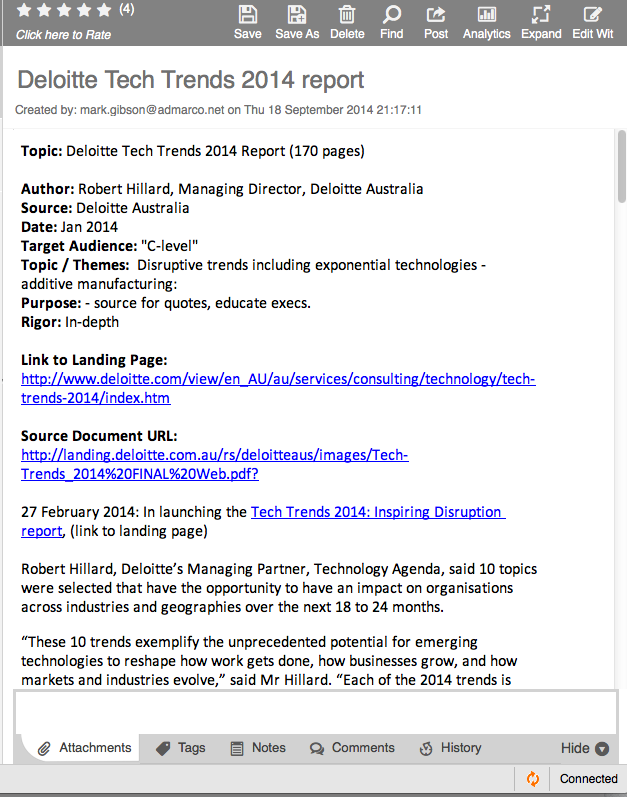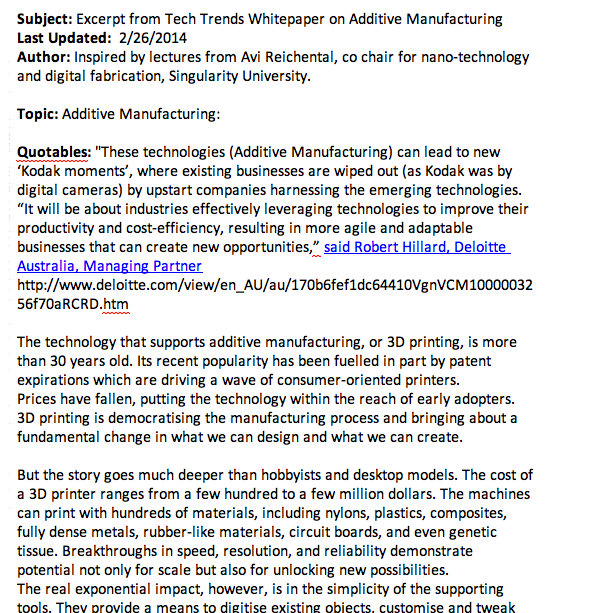Editors, journalists, marketers, sales operations and sales enablement professionals, who curate content for readers to share, should always give it a content header to create value for the receiver.
A content header is an explanatory summary that precedes the content body or link, to help the reader to quickly determine if the content fits their requirement, is useful in other ways, or will work for their customer use-case.
The job of content is to get shared and passed along. A content header multiplies the likelihood that a piece of content will get shared, by an order of magnitude.
A Content Header has 3 Purposes
- It helps the person creating or preparing the content to think clearly about the purpose of the content, the audience and the key themes so it will resonate with the content consumer.
- It helps when requisitioning content from marketers, agencies, and external writers.
- It helps people to deploy the content more effectively, so that it will get shared and read.
When someone creates a piece of content in most businesses today, it may get used once or twice and never see the light of day again.
When content is prepared in a collaborative content ecosystem, it gets created once with a content header, and is available for consumption and reuse by marketing, demand management, sales, channels and support.
Content header enables a fast and convenient, single point of access to enterprise content, regardless of content type or where it is located.
While there are no standards for content headers, this is the one that we use... feel free to use it in your content operations.
Content Header Template:
Thanks to Jim Burns of Avitage for this short content header.
Content Type and Title:
Author:
Source:
Date:
Topics:
Target Audiences (Segments/Roles):
Purpose / Use Cases:
Key points (Facts, Images, Stories):
Quotations:
The following is a true story and a lesson learned.
Earlier this year I sent a link to a whitepaper to a new contact. My contact, (Bill) is an important player in the target account and I felt that the whitepaper had useful insights that Bill would appreciate.
By sending it, he would understand my point of view a little better and after reading the article he would better understand how we could help him achieve his objectives… at least that was my line of thinking at the time.
It is big whitepaper, 170+ pages entitled Tech Trends 2014 and it was produced by Deloitte Australia. Lots of excellent articles and two that I found really aligned with my thinking on couple of disruptive technologies.
Buried on P 149 there was an article of particular interest to Bill. Here is an excerpt of the message I sent to Bill.

But without context, or a reason for reading it and an excerpt of the relevant section, I was doing Bill a disservice. I sent Bill a piece of naked content.
Never Send Naked Content, Dress it with a Content Header
How was Bill to know that buried inside this document there were gold-nuggets of information that he might find interesting and useful for his team in communicating a point of view to their customers?
This is a similar problem that salespeople and knowledge workers face when accessing documents in sales portals and Internet file stores. They don’t know what is in the document, or if it's relevant, until they have downloaded and read it.
By sending naked content I shifted the burden of creating context to Bill and asking him do a lot of unnecessary the work to figure out if it was relevant and useful.
This is something that I should have done in a minute or two that would have made the article really useful, shareable and more valuable.
Let’s review what Bill (and the person receiving your content) has to do when the email arrives.
- Scan it and understand what it is,
- Make a judgment call as to whether the sender has credibility,
- Make a judgment call as whether to click on the link… it could go anywhere, although in this case the full link describes the source and media,
- Read the whitepaper introduction and determine if it’s of interest,
- Find the index and scan it for interest areas,
- Find the time to navigate to the sections of interest and read them.
- Cut and paste excerpts of relevant sections and email to his team, with a content header.
Content Headers Create Context and Value
I use the WittyParrot content delivery platform to index and store source content and to curate, share and deliver both structured documents and plain text content.
Here is a screenshot of the article in WittyParrot. I have included links to the landing page, the source document, an excerpt of the content with a content header and have tagged it so that it can be easily found.

This Wit is 1400 words and has multiple pieces of useful content aggregated within it.
I scrolled down the wit and took this screenshot of the relevant piece that I resent to Bill and for which he thanked me. I simply highlighted this section in WittyParrot and dragged it into the email I sent.

Summary
It takes a few minutes of effort to add a content header to a piece of content.
Those few minutes will likely increase the value and the ROI of the content and the frequency of usage.
By tagging it, it becomes accessible in a search, using logical terms and by giving it a header we enable the viewer to quickly determine if the content is relevant.
If you believe that content is an important enabler of sales success, or if you would like to expore content collaboration platforms and ecosystems, you are invited to find out more.




